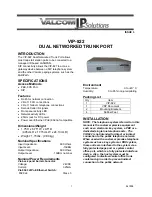
VES-1616F/1624F-44 User’s Guide
Chapter 6 Basic Setting
71
Flow Control
A concentration of traffic on a port decreases port bandwidth and overflows buffer
memory causing packet discards and frame losses.
Flow Control
is used to regulate
transmission of signals to match the bandwidth of the receiving port.
The switch uses IEEE 802.3x flow control in full duplex mode and back pressure flow
control in half duplex mode.
IEEE 802.3x flow control is used in full duplex mode to send a pause signal to the
sending port, causing it to temporarily stop sending signals when the receiving port
memory buffers fill.
Back Pressure flow control is typically used in half duplex mode to send a "collision"
signal to the sending port (mimicking a state of packet collision) causing the sending
port to temporarily stop sending signals and resend later. Select
Flow Control
to
enable it.
802.1P Priority This priority value is added to incoming frames without a (802.1p) priority queue tag.
See
Priority Queue Assignment
in
for more information.
BPDU Control
Configure the way to treat BPDUs received on this port. You must activate bridging
control protocol transparency in the
Switch Setup
screen first.
Select
Peer
to process any BPDU (Bridge Protocol Data Units) received on this port.
Select
Tunnel
to forward BPDUs received on this port.
Select
Discard
to drop any BPDU received on this port.
Select
Network
to process a BPDU with no VLAN tag and forward a tagged BPDU.
Ports 17, 18
Port
This is the port index number.
Active
Select this check box to enable a port. The factory default for all ports is enabled. A
port must be enabled for data transmission to occur.
Name
Enter a descriptive name that identifies this port. You can enter up to 64 alpha-
numerical characters.
Note:
Due to space limitation, the port name may be truncated in
some web configurator screens.
Type
This field displays
10/100
/
1000M
for the Gigabit/ mini GBIC combo ports or
1000M
for
the mini GBIC ports.
Speed/Duplex
Select the speed and the duplex mode of the connection on this port. Choices are
Auto
,
10M/Half Duplex
,
10M/Full Duplex
,
100M/Half Duplex
,
100M/Full Duplex
and
1000M/Full Duplex
.
Selecting
Auto
(auto-negotiation) allows one port to negotiate with a peer port
automatically to obtain the connection speed and duplex mode that both ends support.
When auto-negotiation is turned on, a port on the switch negotiates with the peer
automatically to determine the connection speed and duplex mode. If the peer port
does not support auto-negotiation or turns off this feature, the switch determines the
connection speed by detecting the signal on the cable and using half duplex mode.
When the switch’s auto-negotiation is turned off, a port uses the pre-configured speed
and duplex mode when making a connection, thus requiring you to make sure that the
settings of the peer port are the same in order to connect.
Table 14
Port Setup (continued)
LABEL
DESCRIPTION
Содержание VES-1616F-44
Страница 1: ...VES 1616F 1624F 44 VDSL Switch User s Guide Version 3 50 2 2007 Edition 2...
Страница 9: ...VES 1616F 1624F 44 User s Guide 8 Customer Support...
Страница 23: ...VES 1616F 1624F 44 User s Guide 22 List of Figures...
Страница 27: ...VES 1616F 1624F 44 User s Guide 26 List of Tables...
Страница 35: ...VES 1616F 1624F 44 User s Guide 34 Chapter 1 Getting to Know Your Switch Figure 2 Curbside Application...
Страница 53: ...VES 1616F 1624F 44 User s Guide 52 Chapter 4 The Web Configurator...
Страница 63: ...VES 1616F 1624F 44 User s Guide 62 Chapter 5 System Status and Port Statistics...
Страница 87: ...VES 1616F 1624F 44 User s Guide 86 Chapter 7 VLAN Figure 35 VLAN Static VLAN Port Isolation Setup All Connected...
Страница 90: ...VES 1616F 1624F 44 User s Guide Chapter 7 VLAN 89 Figure 37 Port Based VLAN Setup All Connected...
Страница 93: ...VES 1616F 1624F 44 User s Guide 92 Chapter 7 VLAN...
Страница 103: ...VES 1616F 1624F 44 User s Guide 102 Chapter 10 Spanning Tree Protocol...
Страница 117: ...VES 1616F 1624F 44 User s Guide 116 Chapter 15 Port Authentication...
Страница 139: ...VES 1616F 1624F 44 User s Guide 138 Chapter 18 Queuing Method...
Страница 145: ...VES 1616F 1624F 44 User s Guide 144 Chapter 19 Classifier...
Страница 150: ...VES 1616F 1624F 44 User s Guide Chapter 20 Policy 149 Figure 73 Policy Example...
Страница 151: ...VES 1616F 1624F 44 User s Guide 150 Chapter 20 Policy...
Страница 157: ...VES 1616F 1624F 44 User s Guide 156 Chapter 21 VLAN Stacking...
Страница 165: ...VES 1616F 1624F 44 User s Guide 164 Chapter 22 Multicast...
Страница 173: ...VES 1616F 1624F 44 User s Guide 172 Chapter 23 Multicast VLAN Registration...
Страница 177: ...VES 1616F 1624F 44 User s Guide 176 Chapter 24 DHCP...
Страница 181: ...VES 1616F 1624F 44 User s Guide 180 Chapter 25 Differentiated Services...
Страница 182: ...VES 1616F 1624F 44 User s Guide Chapter 25 Differentiated Services 181...
Страница 183: ...VES 1616F 1624F 44 User s Guide 182 Chapter 25 Differentiated Services...
Страница 193: ...VES 1616F 1624F 44 User s Guide 192 Chapter 27 Maintenance...
Страница 195: ...VES 1616F 1624F 44 User s Guide 194 Chapter 28 Diagnostic...
Страница 199: ...VES 1616F 1624F 44 User s Guide 198 Chapter 29 Syslog...
Страница 259: ...VES 1616F 1624F 44 User s Guide 258 Chapter 33 Command Examples...
Страница 267: ...VES 1616F 1624F 44 User s Guide 266 Chapter 34 IEEE 802 1Q Tagged VLAN Commands...
Страница 277: ...VES 1616F 1624F 44 User s Guide 276 Chapter 35 Troubleshooting...
Страница 281: ...VES 1616F 1624F 44 User s Guide 280 Product Specifications...
















































